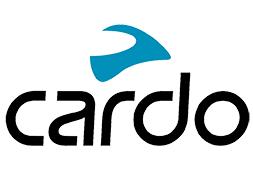
The Different Types of Motorcycle Helmets: Everything You Need to Know
If you’re just getting started riding a motorcycle, the bevy of helmet options can be intimidating to choose from—especially because you’re relying on your choice to save your life. It’s easy to choose a helmet that looks cool, but you already know that you need a lot more from your helmet. You need serious protection, but with features that make it comfortable and practical to wear.
Once you know the different types of motorcycle helmets, it’s much easier to find the model that checks all the right boxes for you.
Let’s take a look at the most common types of motorcycle helmets available on the market today—plus a peek at the helmet communications systems from Cardo Systems that can turn your helmet into its own audio universe.
Full-Face Helmets
For road and highway riding, full-face helmets are generally agreed to be the safest choice. They offer full protection for all areas of the face and head, including a chin bar and a fixed visor. The unibody design of a full-face helmet means that fogging and lack of ventilation can be a problem, so most full-face helmets are designed with ventilation and anti-fogging systems.
Variations also exist within full-face helmet design. Helmets for sportbikes, for example, often have higher chin bars and up-angled visors to accommodate a forward-leaning rider, while cruiser and touring bike helmets are designed for a rider who sits up straight. Most full-face helmets also include movable cheek padding for comfort and stability.
Modular/Flip-Up Helmets
Flip-up helmets include a hinged visor that allows the face shield to be raised up. These helmets are popular for their convenience, but they don’t quite offer the same level of protection as a full-face helmet because the hinge mechanism makes the chin bar slightly less durable. Nonetheless, motorcyclists can find lots of high-quality flip-up models on the market today that will do a great job protecting them.

Open-Face/Three-Quarter Helmets
Most open-face helmets have no chin bar but include protection for the top, back and sides of the head, along with a face shield visor. These helmets offer solid protection for most of your head, although the lack of a chin bar does come with some risks, as the chin and jaw are among the most likely areas to be injured if you’re in an accident.
Half Helmets
A half helmet has neither a chin bar nor a visor–just a dome-shaped upper piece to cover your skull. Unsurprisingly, these offer the least protection of any kind of motorcycle helmet, and they’re the bare minimum required in most states that have laws requiring motorcycle helmets. Their upside is, obviously, vastly increased airflow (perhaps too much if you’re doing highway riding).
Protective eyewear is a must if you choose to rock a half helmet. UV-polarized riding goggles with a backstrap are a preferred option, but anything is better than nothing. Riders who choose half helmets also often wear neck and face guards to keep bugs and dirt from flying into their mouths.
Off-Road Helmets
Off-road helmets are designed with motocross and ATV riders in mind. These helmets are typically lighter than full-face helmets to reduce fatigue and improve airflow, and they include more prominent chin bars.
Off-road helmets typically don’t include a face shield. Instead, off-road riders wear goggles along with the helmet to protect their eyes. For this reason, it’s important to make sure your off-road goggles fit with your helmet, since not all styles may be compatible. Finding a matched set of goggles and a helmet designed to work together is ideal.
Dual Sport Helmets
Dual sport helmets are designed to bridge the gap between off-road and road helmets. They feature the lighter design and prominent chin bars of off-road helmets, but with the extra padding and more heavyweight design of a full-face helmet. If you ride both off-road and street, a dual sport helmet might be a good option.
Choosing the Best Motorcycle Helmet Communications System
Our flagship units like the Cardo Packtalk Slim, Cardo Packtalk Bold and Cardo Freecom series are designed to work with many different kinds of helmets. Whether it’s a full-face model or a lightweight and rugged ATV helmet, Cardo units attach easily and operate seamlessly.
Full-face helmets go great with the styling of the Cardo Packtalk Bold, while the Cardo Packtalk Slim is a great match for helmets with a lighter profile (check out this list of compatible helmets for the Slim). If your taste in helmets runs more toward the open-face or half helmet, check out our Cardo Packtalk Half Helmet Audio Kit, which includes a boom mic and mounting gear. Finally, a set of JBL motorcycle helmet speakers can bring your sound quality into a new dimension.

There’s much more to choosing the best helmet. You’ll also need to know about important stuff like DOT, ECE and Snell ratings, plus how to determine whether a helmet fits your head correctly. Take your time when shopping, find a helmet that feels great and meets the right criteria and take a look at the best-in-class technology of Cardo motorcycle helmet communicators when you need to stay wired on the road.
